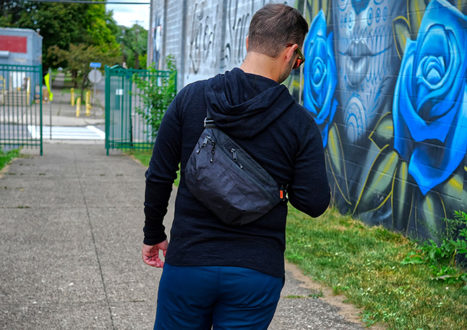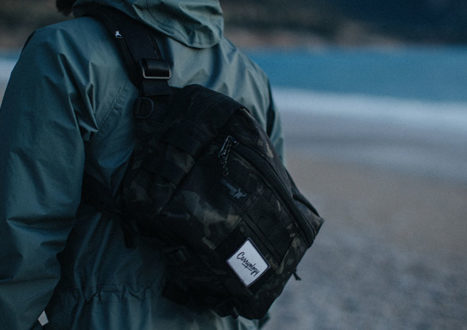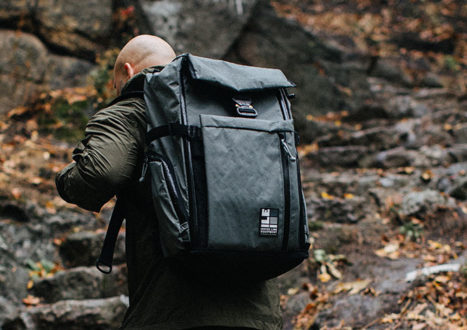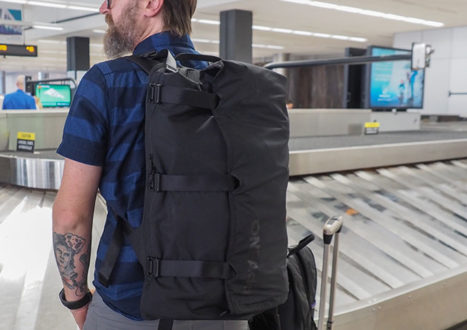
Road Tests
-


Triple Aught Design Axiom 24 Review
Triple Aught Design is well known to our Carry community for making rugged technical gear.... Read more
-

TECH
Apple iPad Pro | Is This the Perfect Mobile Studio for Travel and Adventure?
We’ve spent the last 8 months using Apple’s iPad Pro as a laptop replacement. We’ve taken... Read more
-


EVERYDAY
Ally Capellino Fin Waxed Cotton Backpack Review
The fashion industry is infamous for its prioritization of style over substance, but bag brand Ally... Read more
-


EVERYDAY
The Level Collective Logan Day Pack Review
Some bags are purely functional. Others are all about style. But when you explore bringing both... Read more
-


OUTDOORS
Exo Mtn Gear K3 Review
An external framed backpack is one of the oldest carry inventions – three sticks tied together... Read more
-


OUTDOORS
Hyperlite Mountain Gear Daybreak Review
The Hyperlite Mountain Gear Daybreak is a crossover for outdoor and urban carry. See if it... Read more
-


TRAVEL
Aer Travel Sling 2 Review
Aer is a brand that should be familiar to most within this community. As purveyors of... Read more
-


EVERYDAY
DSPTCH RND Unit Sling Pouch Review
DSPTCH, the camera strap guru turned EDC darling, is in many ways the same company it... Read more
-


Aer City Pack Review
The Aer City Pack fits right in with their iconic look and styling, including their ballistic... Read more
-


EVERYDAY
Tom Bihn Le Grand Derriere Review
If you’ve spent time around the carry community or have been following our site for any... Read more
-


Into Carry Cafe Racer Review
For many of us, consumption is an unfortunate part of our carry hobby. Slowly, larger brands... Read more
-


ORBITGear R101 ADV-VX Review
ORBITGear have proven to be one of the most reactive gear brands I’ve tested so far.... Read more
-


Attitude Supply ARB Tote VX21 Review
Attitude Supply is the brainchild of self-taught Italian designer Michele Fasano. Ever since the successful Kickstarter... Read more
-


Trakke Wee Lug Cobra Review
Trakke is a brand that needs no introduction. Based in Scotland, the small team has been... Read more
-


TRAVEL
Minaal Carry-on 3.0 Bag Review
If you’re a regular reader of Carryology, then Minaal is likely a brand you’re familiar with... Read more
-


EVERYDAY / BIKE
Inside Line Equipment Transit 25L Backpack Review
Reviewing the Inside Line Equipment Transit 25L… Back in 2014, I bought my first fixed gear... Read more
-


ARCH Grisetti Backpack Review
Reviewing the custom-made ARCH Grisetti… I came across ARCH completely by surprise back in 2019 when... Read more
-


Arc’teryx Aerios 30 Backpack Review
It’s not very often when I’m genuinely surprised with a product. But when I unpacked the... Read more
-


EVERYDAY
Tom Bihn Paragon Design Lab and Guide’s Edition Review
The Tom Bihn Paragon provides an updated take on an old-school Tom Bihn design. Take a... Read more
-


Db Element Rolltop Review
Born in 2012, Db is a Norwegian brand that was founded by two passionate individuals, Jon... Read more
-


GORUCK GR3 Review
GORUCK is a brand that demands attention. You have to shout their name whenever you say... Read more
-


Greenroom136 Metromonger Prime Review
There are behemoths out there. Brands that don’t need an introduction and are known even outside... Read more
-


CLIMBING
BUILT TO SEND X2 Backpack Review
When climbing an alpine route in winter there are many things that can possibly go wrong... Read more
-


Arc’teryx Alpha FL 40 Backpack Review
“Exceptionally durable and weather-resistant pack for rock, ice, or alpine climbing. Alpha Series: Climbing and alpine... Read more
-


OUTDOORS
Kasperi Fold Top Backpack Review
I’ve seen many vintage-inspired packs. Honestly, I thought I’d seen them all… and then I discovered... Read more
-


TRAVEL
Wotancraft Pilot Travel Camera Backpack Review
Wotancraft is not new to me, I’ve had their bags and legendary Panerai straps before. When... Read more
-


Instinct Pro Camera Sling Bag Review
Instinct is a London-based brand that was founded in 2018. With two successfully crowdfunded campaigns under... Read more
-


TRAVEL
Inside Line Equipment Travel Pack Review
Putting the Inside Line Equipment Travel Pack to the test… You don’t have to be a... Read more
-


ORBITGear R103 Review
It’s the middle of the night in “Port City” (Japan), the neon lights of the city... Read more
-


Eberlestock F7 Kite Review
I met Glen Eberle at the IWA 2019 show, where he showed me his newest alpine... Read more
-


OUTDOORS
Mystery Ranch Terraframe 50 Review
Having used and abused the Mystery Ranch Dragonslayer for a number of years now, I was... Read more
-


Mission Workshop Khyte Review
Mission Workshop is a brand known for their ability to create the equivalent of an impenetrable... Read more
-


Ancoats Bag Company The Tote Review
When we think about soft goods production, we often imagine a spacious factory somewhere (mainly for... Read more
-


Arc’teryx Brize 25 Review
Arc’teryx is one of my favorite brands for shell jackets; as an alpinist, I love their... Read more
-


EVERYDAY
Alpha One Niner Evade 1.5 Review
Within the carry community there are bags that come along which seem to generate so much... Read more
-


PHOTOGRAPHY
WOTANCRAFT Trooper Camera Bag Review
I really enjoy non-obvious gear, something you can’t easily find in a shop just around a... Read more
-


GORUCK x Huckberry GR1 Slick Review
Ever heard the motto “less is more”? Well, the 21L GR1 Slick could be a definition of that.... Read more
-


The Level Collective Winnats Roll Top Review
So I’ll let you in on a secret. What first captured my attention about The Level... Read more
-


EVERYDAY
Agency Aspect Hybrid Crossbody and Hybrid Messenger Review
A year in testing. Multiple continents. Unforgiving winter weather. Balmy summer sun. On foot. Two wheels.... Read more
-


EVERYDAY / OUTDOORS
Third Block Gear Advanced Field Sling Review
We’d like to welcome new contributor, Jon Custis. Jon is a retired infantryman, currently serving diplomat,... Read more
-


Lundhags Gneik 34 Backpack Review
The Lundhags Gneik 34 has been designed to tackle diverse outdoor adventures, from day hikes to... Read more
-


Mismo M/S Soft Work Briefcase: Road Test
The Mismo brand needs little introduction. Stalwarts in the luxury space with a reputation for durable... Read more
-


Arc’teryx Alpha AR 35 Backpack Review
Yet another lightweight pack in the Arc’teryx lineup…but this time it’s not just a new shape... Read more
-


QWSTION Roll Pack Review: Road Test
When QWSTION unveiled their new Bananatex fabric earlier in the year it was one of the... Read more
-


EVERYDAY
Road Test: ONFAdd Wrapping Backpack
My personal interest in Carryology strikes right through to the tag line: Exploring Better Ways to... Read more
-


OUTDOORS
Arc’teryx LEAF DryPack 25: Road Test
I’m a pack junkie, can’t deny that. So when I unbox a new pack I’m always... Read more
-


PHOTOGRAPHY
Atlas Packs Adventure and Athlete Packs Review: Road Test
Living and working in Hokkaido means gear gets thrashed and usually comes out of a season... Read more
-


BACKCOUNTRY SKI
Mystery Ranch Patrol 35 Pack: Road Test
–Mystery Ranch is a staple among hardcore outdoors professionals and the military. They’ve been designing packs... Read more
-


Arc’teryx Alpha SK 32 Pack: Exclusive Review
Get a sneak peak and dig into an exclusive review of the Alpha SK 32 Pack... Read more





 Carry Awards
Carry Awards Insights
Insights Liking
Liking Projects
Projects Interviews
Interviews
